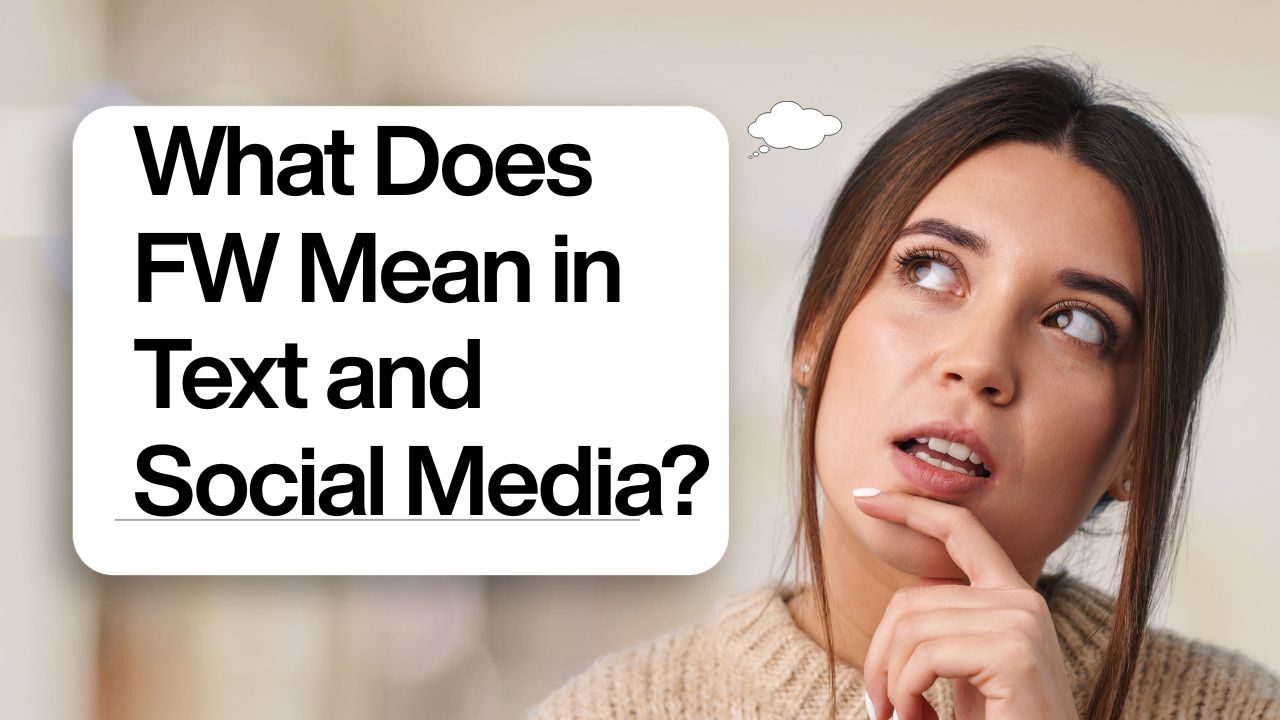Have you ever encountered the term “FW” in a text message or on social media and found yourself wondering what it means? You’re not alone. “FW” has become a widely used abbreviation across different platforms, but its meaning can vary depending on the context.
Whether you’re texting friends, scrolling through Twitter, or reading through emails, understanding what “FW” stands for is important for effective communication. In this blog, we’ll dive into the different meanings of “FW,” how it’s used in various settings, and provide real-life examples to help you master this popular abbreviation.
What Does FW Mean?
“FW” is a versatile abbreviation commonly used in text messaging, social media, and emails. It’s shorthand for several phrases, and its meaning can shift depending on the context. Whether you’re chatting with friends, sharing something on Twitter, or forwarding an email, you might come across “FW” in different forms. Understanding its multiple meanings can help you use it more effectively and interpret it accurately in various situations.
Read more: What Does LWK Mean in Text
Breakdown of “FW” Meanings
Here are some of the most common meanings of “FW” based on context:
- “For When”:
This usage of “FW” is often used to indicate something that is intended for a specific time or occasion. For example, it might refer to something you’re saving for later use.
Example: “FW I get home, I’ll check it out.” - “With”:
In some cases, “FW” can stand for “with,” often seen in casual or abbreviated conversations.
Example: “Can you FW me on that?” (Can you send it to me or share it with me?) - “Forward”:
One of the most well-known uses of “FW” is as shorthand for “forward,” particularly in emails or messages. It’s commonly used when sending someone a message that has been passed along.
Example: “FW: Important Meeting Details” in an email subject line.
Example 1: “FW” in Texting
In texting, “FW” can refer to any of the meanings mentioned above, depending on the conversation. For instance, a message could read, “FW I finish work, we can talk,” meaning “For When I finish work.” Or someone might say, “FW you’re interested, I can send more info” to mean “With you in mind.”
Example 2: Usage in Hashtags, DMs, or Casual Conversations
On social media platforms like Twitter and Instagram, you might encounter “FW” in hashtags or casual posts. Hashtags like #FWIW (For What It’s Worth) are common. In direct messages (DMs), someone might say, “FW, check out this link,” meaning “For your information.” In general, its use is relaxed and informal, making it ideal for platforms like Snapchat, TikTok, or Instagram where shorthand is popular.
Understanding the different meanings and contexts of “FW” will help you interpret and use it correctly across various conversations, whether formal or casual.
Read more: TLDR Meaning
FW on Social Media: How It’s Used
Contextual Examples:
- Twitter: “FW, here’s a funny meme I thought you’d like!”
- Instagram: “FW you’re looking for good food spots, check out my latest post!”
- TikTok: “FW I got this idea from a viral video, here’s my take on it.”
Common Phrases or Hashtags:
- #FWIW: “For What It’s Worth” – Used to add an opinion or perspective.
- #FWB: “Friends With Benefits” – Refers to a casual relationship.
- #FWP: “First World Problems” – Used humorously to refer to trivial issues.
Tone and Informality:
“FW” is mostly used in casual conversations, reflecting a relaxed, informal tone. It helps keep communication brief and to the point, making it ideal for social media, where space and attention are limited.
FW in Text Messaging
- Text Lingo:
In texting, “FW” is commonly used as a shorthand for phrases like “For When,” “With,” or “Forward.” It helps to keep messages brief and direct, fitting well with the informal and quick nature of texting. It’s a way to convey a point efficiently without writing out full phrases. - Usage Tips:
“FW” is best used in casual conversations with friends, family, or colleagues when the tone is informal. It’s not typically appropriate for formal writing or professional communication unless you’re forwarding an email or message. Use it when you’re in a relaxed setting and want to keep the conversation fast-paced and casual. - Examples:
- “FW, I’ll be there at 6.” (For When)
- “FW you’re free later, we should grab coffee.” (With)
- “FW: Email from the boss.” (Forward)
FW in Different Contexts
Business Communication
In professional settings, “FW” is often used to indicate the forwarding of emails or documents. It’s commonly seen in email subject lines, such as “FW: Meeting Agenda” or “FW: Project Update,” signaling that the content has been passed along for review or action. Using “FW” in emails helps maintain clarity and organization in a professional environment, especially when sharing information or following up on communications.
Casual Conversations
“FW” is much more common in informal conversations, particularly in text messaging and social media. In casual settings, it’s used to convey quick information or make light suggestions. For example, a friend might text, “FW you’re up for it, let’s hang out later!” Here, it stands for “For When” or “With,” keeping the tone friendly and relaxed.
Risks of Misunderstanding FW
Ambiguity in Context:
Since “FW” can have multiple meanings, there’s a risk of confusion if the context isn’t clear. For example, if someone texts “FW you’re free,” it could mean either “For When you’re free” or “With you in mind,” depending on how it’s used. Without proper context, the recipient might misinterpret the message.
Professional Miscommunication:
In a business setting, using “FW” informally (e.g., “FW: Sales Report”) may cause confusion if the recipient isn’t accustomed to that shorthand. This can lead to unclear communication, especially in more formal or structured environments.
Misreading Tone:
In casual conversations, “FW” is meant to be informal, but it may seem overly abrupt or unclear if used in the wrong context. For instance, “FW, I’ll call you later” could come off as too blunt without the proper tone, leading to misunderstandings.
Cultural Differences:
Not everyone may be familiar with “FW,” especially those who aren’t accustomed to texting slang or abbreviations. This could create a barrier, particularly in global communications, where slang terms may not translate well.
Conclusion
Understanding what “FW” means is essential for effective communication in today’s digital world. Whether you’re texting a friend, posting on social media, or sending an email, “FW” serves as a convenient shorthand to convey information quickly.
However, it’s important to recognize that “FW” can have different meanings depending on the context, such as “For When,” “With,” or “Forward.” By keeping in mind the setting—whether professional or casual—you can use “FW” accurately and avoid misunderstandings. So, the next time you encounter this abbreviation, you’ll know exactly how to interpret it and how to use it in your own conversations.
Frequently Asked Questions
What does “FW” mean in texting?
In texting, “FW” can stand for several things, including “For When,” “With,” or “Forward,” depending on the context. It’s often used to keep messages brief and casual.
Can “FW” be used in professional emails?
Yes, “FW” is commonly used in business emails, particularly to indicate a forwarded message. For example, you might see “FW: Meeting Agenda” in the subject line to show that the email is being forwarded.
What does “FW” mean on social media?
On social media, “FW” is often used in hashtags or casual posts, such as “#FWIW” (For What It’s Worth) or “FW you’re interested.” It’s a shorthand way to express ideas or share information quickly.
Is “FW” only used in informal communication?
While “FW” is primarily used informally in texts and social media, it can also appear in professional emails, especially when forwarding information. However, it’s not generally used in formal writing.
How do I avoid misunderstanding “FW” in communication?
To avoid confusion, always ensure the context is clear when using “FW.” If you’re uncertain, it’s best to avoid using it in formal communication or when the recipient may not be familiar with the abbreviation.
Are there other abbreviations like “FW” I should know?
Yes, other common text abbreviations include “LOL” (Laughing Out Loud), “BRB” (Be Right Back), and “DM” (Direct Message). It’s useful to familiarize yourself with these to communicate more effectively in digital conversations.

